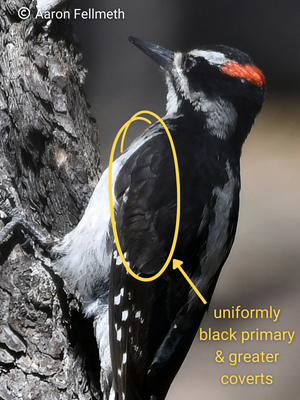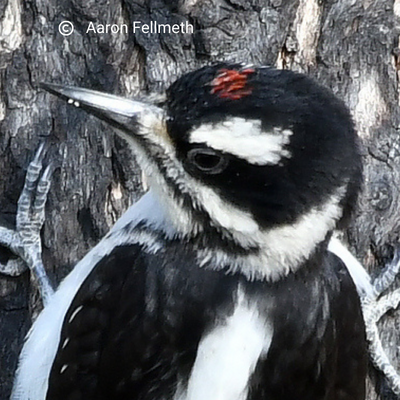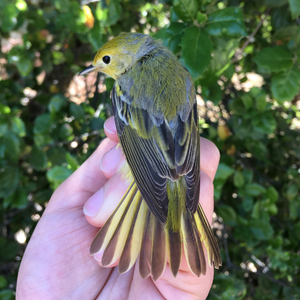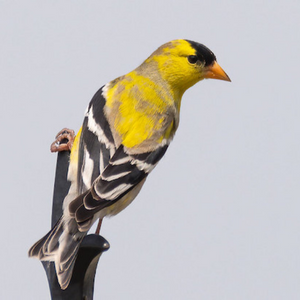These Hairy Woodpeckers were photographed by Aaron Fellmeth in early July in Arizona's White Mountains. The bird on the left is a pretty typical looking male Hairy but the bird on the right was a bit more perplexing.

An ATY (After Third Year) male Hairy Woodpecker. Photo by Aaron Fellmeth.
When it comes to molts and plumages, woodpeckers are just, well, idiosyncratic. Their molts are unique in 1) replacing primaries and rectrices but not secondaries or primary coverts during the preformative molt, 2) beginning this molt with replacement of juvenile inner primaries before fledging, and 3) undergoing incomplete molts of primary coverts and often secondaries during later prebasic molts. As banders now know, once these complex molting patterns are understood, woodpeckers, unlike passerines, can be aged to SY/TY, ASY/ATY, in some cases TY/4Y, and perhaps occasionally even ATY/A4Y! See here and here for details.
The plumages of woodpeckers are somewhat less convoluted. Adults of our common species, such as Downy, Hairy, Nuttall's, Red-bellied, and Pileated woodpeckers, vary little in plumage except that males show red in the head and females lack red. The red of males often (but not always) is restricted to the hindcrown, creating a red bar above the nape that is sometimes divided in the middle by a black streak. Such is the case with Aaron's typical Hairy Woodpecker (HAWO), an ATY (After Third Year) by the uniformly black greater and visible primary coverts and a male by the red in the hindcrown.
So what's up with the bird with red in the center crown? There is one plumage aspect of many woodpeckers that is unique among birds: juveniles can have a trait of adult males, red on the crown, but it does not match where it occurs in adult males. So Aaron's second bird is a juvenile, which has just recently fledged. It will keep this plumage for only a month or two, after which it will undergo the preformative molt and replace the head with feathers typical of adult males...or females.

Red feathers in the center of the crown of a juvenile Hairy Woodpecker. Photo by Aaron Fellmeth.
Females? And here's where it gets really unusual: juvenile females can also show red inthe crown even though adult females show no red! I can think of no other birds in which juvenile females show a character that occurs in older males but not females. The red in the crowns of juvenile females at least averages less than that of juvenile males.
So what sex is Aaron's bird? Typically we say that if the red goes in front of the eyes it is usually a male and if it doesn't it's usually a female, but this may not always be the case, and each species of woodpecker seems to have its own patterns of variation within each sex. To gain more insight, let's turn as usual to the Macaulay Library to find out. There are currently some 83,000 images of HAWO including over 800 that have been tagged as juveniles, so we should get somewhere.
The extent of red in the crown of juvenile HAWOs does vary a lot. It is also often accompanied by white flecks, a plumage trait also not found in adults. Based on seat-of-the-pants analysis along with a pinch of gut instinct, I would consider these HAWOs to be juvenile males: ML30930911, ML60049021, ML150081921; whereas I'd consider these to be juvenile females: ML107288031, ML105861971, ML242064761, as well as those with little or no red in the crown, e.g., ML105861441. So, based on this quick assessment, I suspect Aaron's bird is actually a female, although without a more thorough analysis I'd probably go with unknown sex for now. In the Identification Guide I indicate (and will be indicating in the soon-to-be released 2nd edition) only that juveniles without red can be reliably sexed females and those with "extensive red" can be sexed males, which leaves a lot of room for further study. Another good question, what is the adaptive advantage to juveniles showing red here? Must have something to do with the identification of nestlings and juveniles by parents, but I have yet to see a study on this topic.
Finally there is another odd thing about juvenile HAWOs, in particular among our common woodpecker species, that the red crown coloration in juveniles can be yellow instead, e.g., ML243034191 and ML243735701. Yellow in the crown is something we associate with Black-backed and American Three-toed woodpeckers, so banders and birders should be cautious not to confuse yellow-crowned juvenile HAWOs with juveniles of these other two species, which can also show yellow at the top of the crown.
I suspect that the yellow in the crown of juvenile HAWOs would show similar extents by sex as the red, but who knows? Another good study for banders and those (like me) who have become addicted to trolling the Macaulay Library for information on molts and plumages, not only of our common species but of all of the world's birds. I wonder, for example, how might the crown pattern of male and female Yellow-fronted Woodpeckers (ML61306721, ML364863871) of South America vary in juveniles? What sex would this juvenile be: ML72668421? I better stop now.
If you are interested in having Peter help you ID or age a bird, email good photos, with date and location info to Meredith Walker IBP's communications specialist at mswalker AT birdpop.org. She will compile them for Peter to choose from.






